Signs of Carpenter Ants in Your House & What To Do
Published Date: April 7, 2023

Identifying carpenter ants early in your home could become the difference between a structurally compromised and a sturdy home. Carpenter ants can weaken your home’s structural integrity and cost you dearly on home repairs if you don’t act upon it soon. This article enlightens you on the signs of carpenter ants in your house for your quick action.
Carpenter ants are some of the country’s largest and most destructive ant species. They’re fairly large and usually burrow in wood to create their nests, thus creating voids that affect their structural integrity. Read on to understand these species and how to mitigate their damage to your home through early identification.
Easy Ways to Identify Carpenter Ants
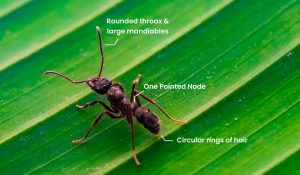
Carpenter ants are fairly large and could measure up to 12mm for worker ants and 20mm for the queens. The average size is about 18mm. Their name comes from their unique carpentry when burrowing through the wood to build smooth tunnels for their nests. They rarely nibble on the wood in which they build their nests. Instead, they forage around the house for food.
You may notice worker ants around the house, foraging for food and building their nests. They prefer wet wood because of the ease of burrowing through weakened wooden material. Also, decayed or damaged wood makes brilliant homes for these ants. It’s the perfect habitat to breed their eggs until they mature into larvae and adult ants.
The insulation they tunnel through can sometimes be frass. Looking closely, you may see that the wood has tiny pinholes. Carpenter ants create these tiny holes when they burrow through the wood in order to force the frass out and continue their tunneling.
Some might easily confuse them with the usual household ants. But they’re bigger than regular household ants and often leave around sawdust as they burrow through the wood. Once you spot these ants in your house, you can easily follow their trail to identify their nest.
Carpenter ants have three body parts (head, thorax, and abdomen), usually black and red. Most have a black abdomen, while the head and thorax combine the two colors.
What Does a Carpenter Ant Nest Look Like
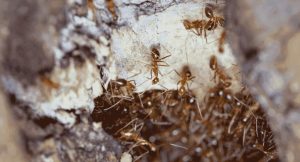
Carpenter ants prefer building their nests in decaying or moist hardwoods and trees. They prefer those with holes where they can get in and out easily while foraging or moving around. These types of wood provide steady temperature and humidity, more so when wet, where they can thrive and grow their colony.
As they burrow through the wood and trees, they’ll push out the sawdust or frass, a subtle sign of their nest’s location. Parent colonies that host the queen and the eggs are always in damp areas, probably areas with plumbing issues or near your kitchen sink or basement.
Satellite colonies can thrive even in dry conditions because they only have workers, pupae, and larvae. The smooth tunnels in the wood structure present a comfortable yet artistic way of carving out their habitat within pieces of wood and trees in your home structure. The voids created might harm your home’s structural integrity and strength, costing you money during repairs.
Carpenter Ants vs. Termites
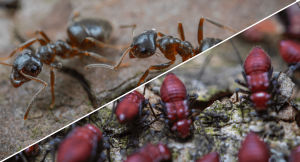
Carpenter ants differ from termites as they don’t feed on wood. They only create tunnels and pave the way for their nests. Termites are more destructive than the former.
However, the appearance and behavior are quite similar except for the waist, antennae, and the wings in winged termites. Winged termites have equal lengths of wings, while carpenter wings have longer front pairs of wings.
Carpenter Ants vs. Black Ants
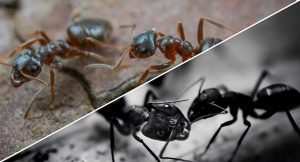
Black ants differ from carpenter ants in their body shape. The former has two irregular or bumpy nodes between the head and the thorax. While carpenter ants have single round parts as you approach the thorax.
Carpenter ants are larger and have heart-shaped heads. In contrast, black ants are small and have round heads.
Signs of Carpenter Ant Damage & Infestations
Homeowners must be keen to identify ant infestations early enough to deal with them effectively. Failure to curb the infestations early might force you to incur thousands or millions of dollars in repairs or reinstallations of critical areas within the home due to structural damage. Here are some warning signs to watch out for
1.Visible Ants:

If you see carpenter ants around your house, then there’s probably an ant’s nest within the home. Seeing large black ants around the house could also indicate the presence of carpenter ants.
2.Frass (Sawdust):
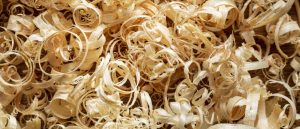
Carpenter ants usually leave trails of dust when burrowing through the wood. They push away the sawdust and shavings when creating their nests and tunnels in the wood. Check out for small stashes of sawdust on the floor or wall near wooden structures. Infested structures could include the attic, door frames, chimneys, cabinets, or window sills around the house.
3.Swarms:
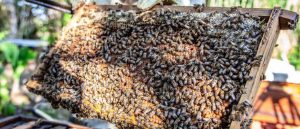
If you notice a swarm of winged carpenter ants around the ceilings and walls, it’s a sure sign of infestation. Colonies of winged or flying ants are a common spectacle during spring when reproducing. They’ll hop onto other nests and colonies to produce new colonies. You must call in experts to identify their nests before they wreck more wood structure damage.
4.Shed Wings:

If you commonly find shredded ant wings around the house while cleaning, you might host a large colony of ants. Check out vents or window sills for these wings showing signs of mature ant colonies ready to reproduce. Call pest infestation experts to examine your home for colonies or swarms.
5.Rustling Sounds in Walls:
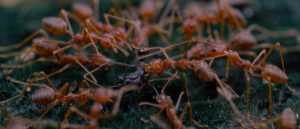
As the carpenter ant colony grows, they must expand their nest. A large colony of more than 10000 worker ants produces ruffling sounds when working on the nest. If you listen in closely, especially at night when it’s quiet, you might hear shuffling sounds indicating their presence. Move quickly to identify the sound’s source. Let an expert examine and deal with the infestation.
6.Ant Droppings:
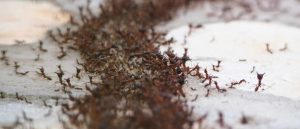
Fecal droppings are a sure sign of ant colonies in your home. You’ll likely be hosting mature worker ants or their pupae which might cause extreme damage if not promptly handled.
Look out for this fecal matter that’s usually bound together with the frass from burrowing around walls, ceilings, or leaderboards. The ants will typically chew and excrete the wood while creating their nest.
7.Trailing Ants:

Worker ants always stray away from the nest, looking for food. A trail of ants around the house indicates the presence of a colony. Worker ants don’t forage more than 300 feet from their nest. When you see them, know their nest is nearby or within your home. You can easily follow their trail back to the nests to identify the damaged wood and infestation area.
8.Hollow-Sounding Wood:

Once ants burrow and tunnel your wooden structures, they’ll leave voids. You have hollow and lighter wooden pieces. When you knock or hit them, they’ll produce an open sound indicating the presence of tunnels (that host their nests).
Regular checkup of the pieces of wood or stumps around the house gives you a good headstart when dealing with carpenter ants. They like living in hollow, decayed, or isolated parts of the wood.
How to Get Rid of Carpenter Ants:
You can use various methods to treat and prevent carpenter ants' infestation. Check out these proven ways to get rid of these ants.
- Set Up a Bait for the Ants: Carpenter ants get attracted to sugary scents and food. Set up a shallow tray or bowl with water. Then, mix sugar and baking soda in a small tin and place them at the center of the bowl. The ants will drown in the water as they follow the sugar scent.Also, you can use color to follow their trail back to the nest. It helps you identify their nest easily. Place a jar of jelly or sweets and allow it to leave a trail as it returns to the nest. Then you can destroy the nest to get rid of them.
- Destroy Their Nest: Destroying their nests prevents further damage to your home. Find out where the nest is and blow or spray in chemicals like boric acid or by removing the wasted wood. However, it might be easier to remove with professional help.
- Clean Up Their Trails: Ensure you clean your house and remove stumps, branches, and other pieces of wood around the house. Ants follow the scent trail they leave behind while foraging for food. Eliminating this scent disrupts their flow. When they can't find their way home, they'll soon disperse, and their numbers will dwindle and die out.Removing wood around your compound eliminates potential breeding and living places. Such wood around the house gives them the perfect environment to set up their habitat. Pools of water with the wood allow them to thrive and grow exponentially.
- Use Insecticides: Chemical treatments are quite effective when killing ants. Consult the pros on which insecticide to use and spray around the house. You don't need to locate the nest for its effectiveness.
- When to Call in the Pros: Call exterminators immediately if you notice carpenter ants or their nests in your home. You can use the mentioned methods of dealing with these pests, like destroying their nests or using insecticides to eliminate them.You'd better call a pro if you didn't do comprehensive work when applying these methods. Pest infestation experts will scan the area for unidentified nests or if you need to destroy the current nest effectively. They'll help you devise preventive measures to keep them off your property.
Our Top Picks for Professional Pest Control
Getting experienced professionals to work with you to eliminate ants in your house is vital. Here are the top 3 recommended best pest control companies.
Discount on residential pest control for employees of Orkin commercial customers

Orkin
Known For Experience & Comprehensive Service
Orkin
Known For Experience & Comprehensive Service
Orkin deals with a wide range of pest infestations on various occasions. They have experienced professionals and use high-tech equipment and research to curb the effects of ant infestation in your home. Here are some standout features of Orkin:
- Use of Integrated Pest Management approach.
- Over 120 years of experience in the pest control industry, providing proven expertise and reliability.
- Offers programs like Precision Protection to help you monitor and control any pest invading your building.
$50 off or Free Termite Inspection + $100 off on rodent and wildlife control

Terminix
Known for Effective Pest Control Solutions
Terminix
Known for Effective Pest Control Solutions
Terminix is an experienced pest control company with 95 years of serving the local community. They have experts who understand the local dynamics but rise above them when looking for solutions for your home. Here are some standout features of Terminix:
- 24/7 customer support and response
- Their trained specialists provide comprehensive treatment and protection for homes against different 12 pests.
- Expansive resources and technology that improve the type of solutions to be implemented
$100 off on scheduling service

Aptive Environmental
Known For Customized pest control plans
Aptive Environmental
Known For Customized pest control plans
Aptive Environmental is a young pest control company that works to serve the local community with diligence and care. With a team of trained professionals, the company offers a wide range of services, including general pest control, termite treatment, and rodent removal. Here are some standout features of Aptive Environmental:
- Tailor-made solutions and processes
- Plans that address current infestations while also proactively preventing future pest problems.
- Sustainable pest control methods
Dangers of Ignoring Signs of Carpenter Ants
Ignoring subtle signs of carpenter ants in the house could be costly financially or structurally. You risk more damage to your home if you don’t deal with these problems aptly. Check out these risks that carpenter ants might expose you to:
- Weaken your home’s support and beams
- Warping of fence or house structures supported by wood
- Costly repairs and maintenance to restore the structural integrity
- Ant bites, which may cause rashes or irritation
Bottom Line
You must take quick action when you notice signs of carpenter ants in your house. Be keen to look for shredded wings, ant trails, and sawdust around the house to identify their presence quickly. Also, understand how to differentiate the various ant species from carpenter ants, termites, and black ants for proper action lest it causes significant havoc in your home.
FREQUENTLY ASKED QUESTIONS (FAQs)
Why do carpenter ants suddenly appear?
Carpenter ants could appear in your home after hibernation as they look for food. If you see them in the early spring, they might look to reproduce into new colonies.
What attracts carpenter ants?
Carpenter ants get attracted to sugary items. They also like to burrow in wood moistened with fungus or water, providing the perfect humidity and temperature for their habitats.
Should I be worried if I see one carpenter ant?
Carpenter ants prefer living in colonies. Thus, if you see one carpenter ant, there’s a huge chance there’s a nest or habitat that hosts other ants. Following its trail would help you eliminate any doubts you might have.
How do you find where carpenter ants are coming from?
You can follow their trail to identify their nests. Or, identify any pieces of wood around your house near moist areas providing a thriving habitat for them. Check out voids or hollow pieces of wood to identify their nests.
Do carpenter ants go away on their own?
Carpenter ants are unlikely to go away on their own once they have established a nest in or near your home. If left untreated, the colony can continue to grow and cause damage to the wood structures of your home. Therefore, it is important to take steps to eliminate the carpenter ant infestation as soon as it is detected.
When are carpenter ants most active?
Carpenter ants are most active at night and during spring.
Can carpenter ants destroy your home?
Carpenter ants can easily destroy your home by compromising the structural integrity of the wooden beams and sections. This will cause them to warp or buckle under stress.
Do Carpenter Ants Eat Wood?
No. Carpenter ants don’t eat wood. They only carve their nests by burrowing the wood.
Where are carpenter ants' nests found?
Carpenter ant nests are in pieces of wood like stumps or logs. Wooden sections in your home, like baseboards, door frames, or window sills, could also make the perfect habitat for the ants.
Where do carpenter ants hide in a house?
Carpenter ants hide in their nests in the basement, walls, or ceilings as they burrow to create comfortable nests.
How do you prevent carpenter ants?
Here are some steps you can take to prevent carpenter ants:
- Eliminate logs and pieces of wood around the house
- Cleaning the ant trails to eliminate their scent
- Avoid pools of water in and around the house
- Keep food in air-tight containers to avoid presenting them with food
How long do carpenter ants last?
Worker ants can last up to 7 to 8 years, while queen ants can live up to 10 years. Depending on the weather, their development into adult ants could take 6 to 10 weeks.
How long can it take to get rid of carpenter ants?
Using less effective methods, like waiting for them to die, could take months to years to get rid of the carpenter ants. However, professional exterminators could take up to a week to clear out the infestation and set you up for an ant-free environment.




